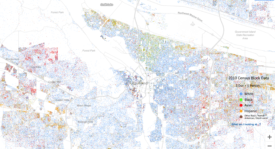Looking for the next weekend reading. Look no further.
Eric dP:
My top recommendation this week is the Boston Globe’s first-rate photo essay on the global coal industry.
I got some laughs from Local Brew’s comedy series. (The snowmadgeddon piece is the best one.)
And with a tip o’ the hat to former Sightline intern Matt Schoellhamer, I note that NBA superstar Lebron James could bring some high-wattage star power to bike commuting. As Matt points out, given the right incentives, even a highly recognizable man, worth something like $120 million, will ride his bike 40 minutes to work once in a while.
Nicole:
Much of the national conversation I’ve heard around our economic health revolves around arguments about shortsighted theory, or the woes of cities and states that are just now buckling under hefty budget cuts and deficits. Louis Ferleger reminds us that, lo, many communities in the United States have been in decline, even for the past 20 years. It’s a solid article that goes into the numbers, limits of the research, implications for the future and, of course, possible solutions for restoring America’s dead zones.
Alan:
Adam Gopnik takes an initially unsettling but ultimately hopeful look at mass incarceration in the United States. The United States’ criminal justice system now ensnares more people than did Stalin’s Gulag, and for black men who lack a highschool diploma, prison is the dominant institution in life. The scale of barbarity conducted in our names is sickening. That’s the unsettling part. The hopeful part is that both Left and Right appear to be mistaken in their assumption that the solutions to crime are deep and structural. Solutions appear to be modest interventions that make crime less convenient to commit. One upshot of this argument is that we should decriminalize marijuana, re-empower judges to use their judgment, and let a lot of people out of prison.
Purely for your aesthetic enjoyment, there’s this little instructional video on how the Dutch ride double on their bikes.
Anna:
Yes! Magazine brings us 7 tools to shut down the “corporatocracy.” Here are a couple spoilers: We can get our governments to quit banking with Bank of America and Chase, and start our own state banks—14 states, including California and Washington, are considering such a move. And…Call for a constitutional amendment overturning Citizens United, corporate personhood, and the unfounded notion that money is the same thing as speech. So far, Los Angeles, New York City, and about 50 other towns and cities have already done so.
Ruy Teixeira of Center for American Progress looks at a just-released poll showing that Americans think wealthy citizens should pay their fair share.
They can say what they want about “Obamacare” but there’s some reform on the horizon that looks awfully good to me. For one thing, how about the end of health insurance companies entirely by 2020? (I say good riddance!) And in their place, “accountable care organizations” that, as this NYT “opinionator” predicts, will effectively shift the focus of medicine away from simply treating sickness (and making astronomical profits for insurance companies) and toward prevention and actually keeping people healthy—not to mention getting their medical visits covered (instead of dodging payments and forcing people to forgo necessary care).
Clark:
Researchers look at the psychology (and evolution) of disgust. There’s a welter of new data on disgust, since it’s “easier to elicit in an ethical manner than anger or fear. You don’t have to insult someone or make anyone afraid for his or her life — a bad smell will do the trick.” Interestingly, some research suggests that political conservatives are more prone to sensations of disgust, particularly around sex, than political liberals. And as with any emerging field of research, disgust has spawned a host of conflicting theories and taxonomies: there are either three, seven, or nine different categories of disgust reactions, depending on who you believe.
Infographic: Can Twitter help create smarter traffic routes? Some genius has used geotagged tweets to show the movement of people through New York, San Francisco, and LA. It shows a virtual “desire path” through the cities — the routes they actually take, rather than the ones that city planners intended them to.
And in case you hadn’t heard about desire paths (I hadn’t), here’s Wikipedia:
A desire path (also known as a desire line or social trail) is a path developed by erosion caused by footfall. The path usually represents the shortest or most easily navigated route between an origin and destination. The width and amount of erosion of the line represents the amount of demand…
…The path of Interstate 95 between the cities of Boston and Providence in the USA is said to have originated as a desire line in the form of a trail followed by 17th century Native Americans, which subsequently became a primitive turnpike and eventually a superhighway.
Eric H
I’ve been following the Susan G. Komen debacle closely, not just because of the implications for women’s basic health care, but as an amazing case study in social media failure. After days of silence and one-note replies to the issue, Komen reversed the decision to strip Planned Parenthood of grant funding—but not in time to stop some serious damage to its brand.
Eric Jaffe, over at Atlantic Cities, sums up new research on the gender imbalance of transit planning.
Finally, here’s a beautiful time lapse video of Yosemite:







